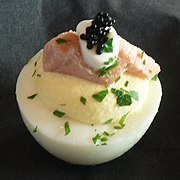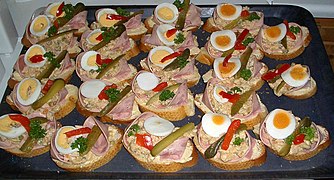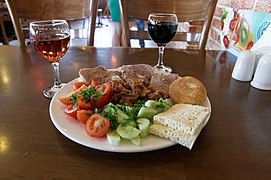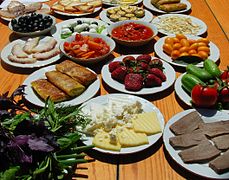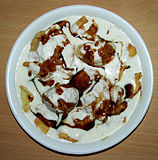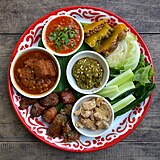Hors d'oeuvre
| Part of a series on |
| Meals |
|---|
 |
| Meals |
| Components and courses |
| Related concepts |
|
An hors d'oeuvre (/ɔːr ˈdɜːrv(rə)/ or DURV(-rə); French: hors-d'œuvre [ɔʁ dœvʁ] ⓘ), appetiser[1] or starter[2] is a small dish served before a meal[3] in European cuisine. Some hors d'oeuvres are served cold, others hot.[4] Hors d'oeuvres may be served at the dinner table as a part of the meal, or they may be served before seating, such as at a reception or cocktail party. Formerly, hors d'oeuvres were also served between courses.[5] There are two types of hors d'oeuvre from service point of view:
- General hors d'oeuvre
- Classical hors d'oeuvre
General hors d'oeuvres include
Typically smaller than a main dish, an hors d'oeuvre is often designed to be eaten by hand.
Etymology
Hors d'œuvre in
Origins
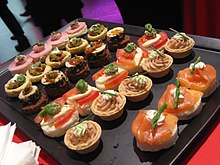
A small number of food historians believe that the tradition may have begun in Russia, where small snacks of fish,
French service
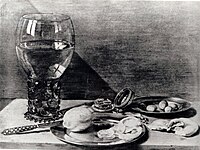
During the
At about this time in the 17th century, smaller dishes began to be served by being placed outside the main work of symmetrically placed dishes. These were known as hors d'oeuvre.[10][13] Hors d'oeuvres were originally served as a canapé of small toasted bread with a savoury topping before a meal.[14] The first mention of the food item was by François Massialot in 1691, mentioned in his book: Le cuisinier roial et bourgeois (The Royal and Bourgeois Cook) and explained as "Certain dishes served in addition to those one might expect in the normal composition of the feast".[15] In the French publication Les plaisirs de la table, Edouard Nignon stated that hors d'oeuvres originated in Asia. He went on to state that the French considered hors-d'oeuvres to be superfluous to a well cooked meal.[16] Service à la française continued in Europe until the early 19th century.[10][13] After the 19th century the entremet would become almost exclusively a sweet dish or dessert with the British custom of the "savoury" being the only remaining tradition of the savoury entremet.[13]
The style of formal dining changed drastically in the 19th century, becoming successive courses served one after the other over a period of time.[10][12] Some traditional hors d'oeuvres would remain on the table throughout the meal. These included olives, nuts, celery and radishes. The changing, contemporary hors d'oeuvres, sometimes called "dainty dishes", became more complicated in preparation. Pastries, with meat and cream sauces among other elaborate items, had become a course served after the soup.[10]
English savouries
As a result of French influence on the
American appetisers and cocktail hors d'oeuvres

The term appetiser (
Preparation
In restaurants or large estates, hors d'oeuvres are prepared in a garde manger which is a cool room.[28][page needed] Hors d'oeuvres are often prepared in advance. Some types may be refrigerated or frozen and then precooked and then reheated in an oven or microwave oven as necessary before serving.[29]
Use

If there is an extended period between when guests arrive and when the meal is eaten, for example during a cocktail hour, these might serve the purpose of sustaining guests during the wait, in the same way that apéritifs are served as a drink before meals.[30]
It is also an unwritten rule that the dishes served as hors d'oeuvres do not give any clue to the main meal.[31] They are served with the main meal menu in view either in hot, room temperature or cold forms; when served hot they are brought out after all the guests arrive so that everyone gets to taste the dishes.[citation needed]
Hors d'oeuvres before a meal may be rotated by waiters or passed. Stationary hors d'oeuvres served at the table on a tray may be referred to as table hors d'oeuvres or as buffet-style.[32] Passed hors d'oeuvres provided by servers are part of butler-style service.[32] or butlered hors d'oeuvres.[33]
Examples
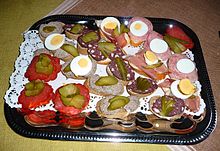
Though any food served before the main course is technically an hors d'oeuvre, the phrase is generally limited to individual items, such as cheese or fruit. A glazed fig topped with mascarpone and wrapped with prosciutto is an hors d'oeuvre, and plain figs served on a platter may also be served as hors d'oeuvres.[34] It could be pickled beets or anchovy eggs as topping over tomatoes as part of the initial "drinks" session such as of alcoholic or non-alcoholic beverages. They are also served in the forms of dips, spreads, pastries, olives or nuts with or without a base of egg, cheese, meats, vegetables, seafood or breads.[29] Single cold items served are smoked salmon, avocado pear, caviar, pâté, shellfish cocktails and melon with garnishes and decorations. Seasoned hot dishes served are of vegetables, meat, fish, egg, pasta, cheese, soufflés, tartlets, puff pastry or choux pastry.[35]
- Bruschetta (Italian pronunciation: [bruˈsketta] ⓘ)[36]
- Canapés[37]
- Caviar[38]
- Charcuterie[39]
- Devilled eggs[40]
- Dumplings[41]
- Gherkin[42]
- Pigs in a blanket[43]
- Smoked egg[44]
- Spanakopita[45]
- Tongue toast[46]
- Hors d'oeuvres
-
Appetisers in a restaurant
-
Tomato bruschetta
-
Deviled eggs, a cold hors d'oeuvre
-
Hors-d'oeuvre, Georgia
-
Hors d'oeuvres in Azerbaijani cuisine
By culture and language
In the Americas
In
In Asia
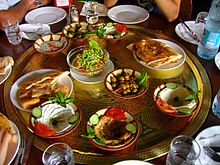
In
Zensai (前菜, lit. before dish) is Japanese for an hors d'oeuvre; commonly for western dishes, ōdoburu (オードブル), which is a direct transcription of hors d'oeuvre, is used.[54][55][56] In Korea, banchan (반찬) is a small serving of vegetables, cereals or meats. Additional Korean terms for hors d'oeuvres include jeonchae (전채), meaning "before dish" or epita-ijeo (에피타이저), meaning "appetiser".[52] In Vietnamese Đồ nguội khai vị ("cold plate first course") is the name for an hors d'oeuvre.[citation needed] In Mandarin, lěng pán 冷盘 ("cold plate") or qián cài 前菜 ("before dish") are terms used for hors d'oeuvres, which are served in steamer baskets or on small plates. [52] Meze is a selection of small dishes[57] served in Mediterranean cuisine, Middle Eastern cuisine, and Balkan cuisine. Mezedakia is a term for small mezes.[57] Pembuka (lit. "opening") is Indonesian for an hors d'oeuvre.[58] Yemekaltı is Turkish for an hors d'oeuvre.[59] [52] Caviar served in Iran is the traditional roe from wild sturgeon in the Caspian and Black Seas. [60]
-
Chaat, a starter in Indian cuisine
-
A sampling of starters in Northern Thai cuisine (Lanna cuisine)
-
Zensai in Japanese cuisine
In Europe

In
-
Various hors d'oeuvres at a banquet of Romanian cuisine
-
An appetiser served at a restaurant serving Swiss cuisine
-
Typical Carinthian or Styrian "Brettljause", composed of different kinds of cold meat, horseradish, hard-boiled egg, meat paste, Liptauer, vegetables, butter and curd cheese
In the United States
In the United States the custom appears to have come from California, where a foreign saloon owner may have put out trays of simple hors d'oeuvres to serve his customers. This tradition soon became the 5-cent beer and free lunch in early America before prohibition ended the custom.[9]
In the U.S., 'appetizers',[69] referring to anything served before a meal, is the most common term for hors d'oeuvres. Light snacks served outside of the context of a meal are called hors d'oeuvres (with the English-language pluralization).[70][71]
Hawaii
In the
In Oceania
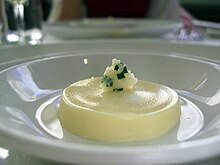
Hors d'oeuvres, also called amuse-bouches, served around bars in Australia are oysters and alsace foie gras.[77] Appetisers in New Zealand are lamb skewer or blue cod sliders.[78] In New Zealand the Māori call their snacks Kai Timotimo.[79] Kiribati appetisers served include pastes made from chickpeas and eggplant, meat dishes with spices and wheat.[80] Samoan foil chicken and roast pork, tidbits of meat in a smoky, spicy sauce are appetisers in Samoa.[81] In Tonga, puu-puus or appetisers served are Waikiki shrimp and grilled pineapple with dipping sauce.[82]
In other countries
Appetisers served in Kenya are raw and fresh vegetables and assorted dips with decorations.[83] Before modern-day hors d'oeuvre were introduced from Europe into South Africa, starters served consisted of eastern fish sambals and cooked bone marrow served with bread.[84]
See also
- List of hors d'oeuvre
- Barquette
- Cicchetti
- Crostini
- Dim sum
- Finger food
- Gujeolpan
- List of foods
- Picada
- Pinchito
- Pincho
- Side dish
- Small plates
- Sushi
- Tapas
References
- ^ ISBN 978-81-207-1930-9. Archivedfrom the original on 12 November 2023. Retrieved 10 January 2016.
- ^ Cracknell & Kaufmann 1999, p. 87.
- ISBN 978-0-19-966615-7.
- ISBN 1-86152-873-6.
- ^ Oxford English Dictionary, First Edition, 1899 s.v. Archived 17 November 2020 at the Wayback Machine
- ^ "17 and 13 Courses of French classical menu sequence with examples (PDF)". Food and Beverage service knowledge. 6 August 2020. Archived from the original on 14 April 2022. Retrieved 14 April 2022.
- ISBN 978-1-4081-0160-5. Archivedfrom the original on 12 November 2023. Retrieved 10 January 2016.
- ISBN 978-1-4990-4630-4. Archived from the original on 12 November 2023. Retrieved 10 January 2016.[self-published source]
- ^ ISBN 978-1-5040-0454-1. Archivedfrom the original on 12 November 2023. Retrieved 10 January 2016.
- ^ ISBN 978-0-19-530796-2. Archivedfrom the original on 12 November 2023. Retrieved 10 January 2016.
- ^ a b Smith 2003, p. 27.
- ^ ISBN 978-1-4926-0303-0. Archivedfrom the original on 12 November 2023. Retrieved 10 January 2016.
- ^ ISBN 978-0-19-931361-7.
- ^ ISBN 978-0-313-08689-2.
- ISBN 978-0-520-24400-9.
- ISBN 0-8014-8647-5.
- ISBN 978-1-134-42542-6.
- ^ ISBN 1-86152-873-6.
- ISBN 9780517503331.
- ^ S. Beaty-Pownall (1905). The "Queen" Cookery Books ... H. Cox. p. 41.
- ISBN 978-1-4532-7161-2.
- ISBN 978-0-313-31685-2.
- ISBN 9780773503069.
- ISBN 978-0-393-24195-2.
- ISBN 978-1-78303-639-4.
- ISBN 978-0-313-38049-5.
- ISBN 978-1-4413-0045-4. Retrieved 27 December 2015.
- ISBN 978-0-470-58780-5. Archivedfrom the original on 12 November 2023. Retrieved 10 January 2016.
- ^ a b Rombauer et al. 1997, pp. 143–44.
- ISBN 978-0-7432-6738-0. Archivedfrom the original on 12 November 2023. Retrieved 10 January 2016.
- ISSN 0164-8497. Archived from the original on 12 November 2023. Retrieved 22 December 2015.)
{{cite magazine}}: Cite magazine requires|magazine=(help - ^ ISBN 978-0-471-66377-5.
- ISBN 978-0-9638939-0-1.
- ISBN 1-86152-873-6. Archivedfrom the original on 12 November 2023. Retrieved 10 January 2016.
- ^ Foskett et al. 2014, p. 11.
- ISBN 978-1-4521-0032-6.
- ISBN 978-1-4413-1093-4.
- ISBN 978-0-8493-9849-0.
- ISBN 1-86152-873-6.
- ISBN 978-0-7627-9222-1.
- ISBN 978-0-684-80077-6.
- ISBN 978-0-7506-6899-6.
- ISBN 978-0-307-71879-2.
- ISBN 978-1-4081-0218-3.
- ISBN 978-1-56426-501-2.
- ISBN 978-1-55092-553-1.
- ISBN 978-0-85745-220-7.
- ^ Romero 2007, p. 48.
- ISBN 978-1-58843-607-8.
- ISBN 978-1-55868-634-2.
- ^ "Exploring Australian Home Cookery: a vintage cookbook from the 1930s". Good Food. 4 November 2014. Archived from the original on 22 December 2015. Retrieved 21 December 2015.
- ^ a b c d e Foskett et al. 2014, p. 10.
- ^ "Mouthful of joy". The Hindu. 11 February 2004. Archived from the original on 7 September 2018. Retrieved 21 December 2015.
- ISBN 978-4-7700-3049-8.
- ^ WAttention Co., Ltd. (22 January 2014). WAttention Tokyo VOL.10. ゴマブックス株式会社. p. 14. GGKEY:LQA0UQUGNC3.
- ISBN 978-0-07-148296-7.
- ^ ISBN 978-0-8118-3148-2.
- ISBN 978-979-22-1630-1.
- ^ "TÜRK DİL KURUMU". tdk.gov.tr. Archived from the original on 22 December 2015. Retrieved 18 March 2015.
- ^ Davidson 2006, p. 150.
- ^ "How to make the best devils on horseback". Metro. 19 December 2012. Archived from the original on 22 December 2015. Retrieved 21 December 2015.
- ISBN 978-1-4602-4304-6.
- ^ Willan 2012, p. 245.
- ISBN 978-1-4391-4518-0.
- ISBN 978-989-23-1186-9.
- ISBN 978-0-88091-428-4.
- ISBN 978-90-6238-304-7.
- ^ Wright 2003, p. 243.
- ISBN 978-0-7645-9562-2.
Appetizers from Hors d'oeuvre To create appetizers from hors d'oeuvre, the portion size ...
- ^ "Chicken – Description of Parts". RecipeTips.com. Archived from the original on 20 February 2007. Retrieved 21 December 2015.
- ^ "The History of Chicken Fingers". Leite's Culinaria. 7 September 2010. Archived from the original on 9 January 2016. Retrieved 21 December 2015.
- ISBN 978-1-4398-5688-8.
- ISBN 978-0-313-34492-3.
- ISBN 978-1-59921-772-7.
- ^ ISBN 978-1-4022-5004-0.
- ISBN 978-0-313-37699-3.
- ^ Louis et al. 2012, p. 434.
- ISBN 978-0-8041-4251-9.
- ^ "Kitchen Terms – Māori Glossary". Māori Television. Archived from the original on 5 January 2016. Retrieved 12 January 2016.
- ISBN 978-1-931694-36-0.
- ^ Cue: The Weekly Magazine of New York Life. Cue Publishing Company. April 1976. p. 19.
- ISSN 1531-2623.
- ^ Dunham 2004, p. 89.
- ^ Wyk & Barton 2007, p. 8.
Bibliography
- Cracknell, H. L.; Kaufmann, R. J. (1999). "Chapter 6: Hors-d'oeuvre". Practical Professional Cookery. Cengage Learning. pp. 87–108. ISBN 978-1-86152-873-5.
- ISBN 978-0-19-280681-9.
- Dunham, J. R. (April 2004). Two Women in Africa: The Ultimate Adventure. iUniverse. ISBN 978-0-595-31232-0.
- Foskett, David; Paskins, Patricia; Rippington, Neil; Thorpe, Steve (29 August 2014). Practical Cookery for the Level 3 NVQ and VRQ Diploma, 6th edition. Hodder Education. ISBN 978-1-4718-0671-1.
- Louis, Regis St; D'Arcy, Jayne; Gilbert, Sarah; Harding, Paul; Le Nevez, Catherine; Maxwell, Virginia; Pozzan, Olivia; Watson, Penny (1 May 2012). Lonely Planet East Coast Australia 4. Lonely Planet. ISBN 978-1-74220-660-8.
- Romero, Pedro (2007). Night+Day Mexico City. ASDavis Media Group. ISBN 978-0-9776245-6-0.
- Rombauer, Irma S.; Becker, Marion Rombauer; Becker, Ethan; Guarnaschelli, Maria (5 November 1997). JOC All New Rev. – 1997. Simon and Schuster. ISBN 978-0-684-81870-2.
- Smith, Dennis Edwin (2003). From Symposium to Eucharist: The Banquet in the Early Christian World. Fortress Press. ISBN 978-1-4514-0653-5.
- Willan, Anne (23 March 2012). The Country Cooking of France. Chronicle Books. ISBN 978-1-4521-0767-7.
- Wright, Clifford A. (1 January 2003). Little Foods of the Mediterranean: 500 Fabulous Recipes for Antipasti, Tapas, Hors D'Oeuvre, Meze, and More. Harvard Common Press. ISBN 978-1-55832-227-1.
- Wyk, Magdaleen Van; Barton, Pat (2007). Traditional South African Cooking. Struik. ISBN 978-1-77007-407-1.
Further reading
- "Bon Appetit's Guide to Modern Hors d'Oeuvres". Bon Appétit. 4 October 2012. Retrieved 21 December 2015.



